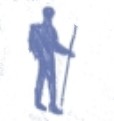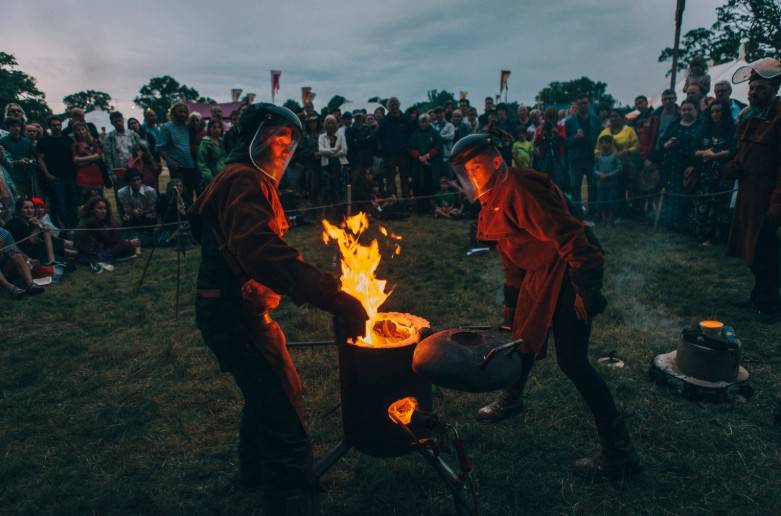Published in Dark Mountain
December 2015
It takes several days to make a bell: two or three to prepare the mould, one to pour the molten bronze, another to clean and polish it once it has cooled. In the age before industrialisation, when transporting heavy objects by road was much harder than today, they were often made by itinerant founders who travelled from town to town, and church to church, making bells on site – building a furnace and kiln in the grounds of a church or monastery, constructing a mould from loam, and asking the local landowner for silver to give the bell ‘a nice silvery ring’ (the silver, more often than not, would end up in the founder’s pocket and no one would be the wiser). Other customs and superstitions surround the craft of making bells, not all of them connected with minor acts of theft. In Germany, bells were embossed with sage leaves as symbols of good luck, reflecting older pagan beliefs, and all over Europe bells were baptised before being rung for the first time, endowing them with a soul. The creation of a bell has always been an event of deep symbolic importance in the life of a community.
The tradition of itinerant bell-making is continued today by David Snoo Wilson and Jo Lathwood, who have built a travelling foundry they can unload from the back of a van. Most of their kit is homemade – the furnace and kiln are built from recycled gas canisters – and their knowledge self-taught, partly from Dave’s journeyman visits to foundries in Central Europe but mostly from trial, error and plenty of spilled metal. For several years they have founded bells at festivals, weddings and other happenings, and a couple of summers ago they invited me to join them. I help with a couple of practical things – skimming the impurities, or ‘dross’, from the surface of the golden soup – but my main role is to explain to spectators what’s going on. With their visor-like face shields, and the roar of the furnace, it’s hard for Dave and Jo’s voices to be heard. So I provide the words. I tell the stories.
At the end of last month, Brighton’s ONCA Centre for Art and Ecology commissioned us to make a bell to be rung on the 30th November – the International Remembrance Day for Lost Species, which has been observed every year since 2011. The event has emerged from a convergence of extinction-related memorials that have appeared in Brighton in recent years, notably Feral Theatre’s carnivalesque Funerals for Lost Species, and the stone-by-stone growth of the Life Cairn on the nearby Sussex Downs. Similar observances have mushroomed across the world, including funeral pyres for the great auk in Scotland and Wales, a candlelit vigil for butterflies in Belgium, and cairns for lost species appearing from Sweden to the Galapagos Islands.
There are various names for what’s happening, and most of them will be familiar to readers of this blog – the Sixth Extinction, the Holocene Extinction, the age of mass ecocide. Whatever you call it, it has the distinction of being the only so-called ‘extinction event’ to be caused by the actions of one species: us. It started perhaps 13,000 years ago with the disappearance of the megafauna – the wooly mammoths, cave bears and ground sloths alongside whom modern humans evolved – but has accelerated massively since the start of the industrial era, when our ability to wreck havoc on the non-human lifeforms that share our planet has reached awesome proportions. By one estimate, the Earth has lost 40% of its wildlife in the past 40 years. By another, 140,000 species vanish every year. These statistics are meaningless, of course – as unhelpful for comprehending disaster as knowing how many units of carbon enter the atmosphere every hour – and push the horror of what’s happening into the abstract realm of statistics, safe from emotional access. There are landmark dates that bring the story closer, garnished with brutal facts: the last dodo was shot or clubbed to death in 1662, the last great auk was strangled by a sailor in 1844, the last passenger pigeon died alone in a cage in 1914, the last western black rhino was butchered by poachers in 2011. Then there is the knowledge of future extinctions, as inevitable as sea-level rise: two and a half weeks ago, with the death of an individual named Nola, a quarter of the northern white rhino population vanished in an afternoon.
Neither the statistics nor the stories seem enough to help us understand such loss. So how can we start to comprehend it? How can we process this great unravelling? We need something more than facts and words – and this, I think, explains the emergence of the lost species funerals, the building of cairns, the remembrance vigils and all the other expressions of grief that our times seem to make necessary. Loss of life, on any scale, has always engendered ritual.
Bells are ritual tools. We have used them for a long time. The first bells appeared in Neolithic China about 5,000 years ago, and they made their way from east to west with migration, trade and religion, arriving in Western Europe in the 4th and 5th centuries AD. Our English word ‘bell’ comes from the Saxon bellan, meaning to bawl or bellow. A Celtic word for bell was clocca, from which we get the word ‘clock’ – from the earliest times bells have been associated with the measurement of time, giving shape and structure to the day. In Christian communities they regulated every part of daily life, telling people when to wake up, when to eat, when to sleep and when to pray – on a larger scale, they marked the thresholds of life and death. Bells were rung to announce birth, to celebrate marriage and to mourn death – they warned of impending disaster, of war, invasion, fire and flood, and were rung to celebrate the occasional outbreak of peace. They were tolled in times of loss. They were tolled to help people remember.
We founded the Bell for Lost Species on a windy Sunday afternoon on the Level, a traffic-ringed strip of grass that runs towards Brighton’s seafront. From the back of Dave’s van we unloaded two canisters of propane gas, our furnace, our kiln, our crucible, a medieval-looking assortment of tools including tongs and an iron ‘cradle’ to transport extremely hot metal, placed 4kg of bronze in the crucible, and fired up the furnace. The bell mould, made of ceramic shell – and embossed with the extinction symbol and a beautiful design by seven-year-old Jared Masters depicting the extinct island rail – was placed in the kiln to heat to the temperature of 1100 degrees. We waited, drinking tea. A small audience assembled. We donned our heatproof leather tunics, aprons, gloves and face shields. The bronze began to sweat, and drip, and slide into liquid form like butter melting in a pan, and as this alchemy took place I read a roll call of the names of creatures we will never see again – the auroch, the giant short-faced bear, the Darling Downs hopping mouse, the elephant bird, the Syrian wild ass, the pig-footed bandicoot, the Ilin Island cloudrunner, the laughing owl, the bluebuck, the quagga, the sharp-snouted day frog, the tarpan, the turquoise-throated puffleg – and when the bronze was at temperature, and flux had been thrown in the liquid metal to separate the pure from the dross, we turned the roaring furnaces off. There was a lovely silence. In this silence we asked those assembled to think about why they were there – to respectfully mourn the death of life, to give focus and clarity to grief. And then Dave and Jo cradled the crucible over to the mould, glowing bright orange-hot, and poured out the liquid bronze. Some people applauded, some cried.
On the evening of the 30th November, the Bell for Lost Species was rung. It was tolled 108 times – a sacred number in Hindu, Buddhist and Jain religious traditions – while a small audience listened in the rain. The reverberations hung in the air like the names of the species spoken aloud – and then, like the species themselves, they faded into nothing.


